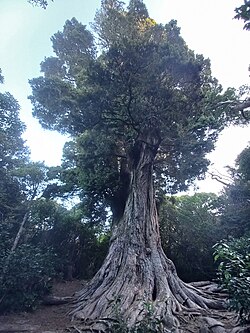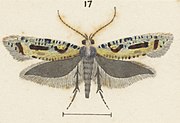Biology:Chrysorthenches porphyritis
| Chrysorthenches porphyritis | |
|---|---|

| |
| Scientific classification | |
| Domain: | Eukaryota |
| Kingdom: | Animalia |
| Phylum: | Arthropoda |
| Class: | Insecta |
| Order: | Lepidoptera |
| Family: | Plutellidae |
| Genus: | Chrysorthenches |
| Species: | C. porphyritis
|
| Binomial name | |
| Chrysorthenches porphyritis (Meyrick, 1885)[1]
| |
| Synonyms[2] | |
| |
Chrysorthenches porphyritis is a species of moth of the family Plutellidae.[3] It was first described by Edward Meyrick in 1885 and is endemic to New Zealand. This species can be found on both the North and South Islands in open native forest and scrub at altitudes from sea level up to 1370 m. The larvae feed on Podocarpus laetus, P. totara, P. nivalis, and Phyllocladus alpinus. The larvae create a shelter by loosely spinning together the leaves of its host plant and can be found feeding in groups. The pupa is formed inside a thin cocoon. Hudson was of the opinion that this species had two broods a year. Adult moths are on the wing all year round. The adults of this species, particularly the female, are variable in colouration and in forewing pattern.
Taxonomy
This species was first described by Edward Meyrick in 1885 and named Orthenches porphyritis.[4][2] Meyrick went on to give a more detailed description of the species in 1886.[5] In 1901, thinking he was describing a new species, Meyrick again named this moth Ypononmeuta cuprea.[6] Meyrick synonymised this name in 1923.[7] In 1927 Alfred Philpott studied the male genitalia of this species.[8] George Hudson discussed and illustrated this species in his 1928 book The butterflies and moths of New Zealand and again discussed the species in his 1939 book A Supplement to the butterflies and moths of New Zealand.[9][10] In 1996 John S. Dugdale placed this species in the genus Chrysorthenches.[2] The female lectotype, collected in Dunedin in August, is held at the Natural History Museum, London.[11]
Description
Meyrick described the larvae of the species as follows:
Larva 16-legged, moderate, cylindrical, rather tapering at both ends ; dull light greenish - ochreous ; dorsal narrow, ochreous-whitish, bordered on each side by a slender dull reddish-fuscous streak, coalescing towards extremities ; head brownish-ochreous[5]
Meyrick described the adults of the species as follows:
Male, female. — 11-14 mm. Head light ochreous. Palpi long, light ochreous or whitish, externally suffused with dark fuscous, terminal joint twice as long as second. Antennae whitish, annulated with dark fuscous. Thorax ochreous, mixed and suffused with purplish and dark fuscous. Abdomen grey. Legs dark fuscous, apex of joints and posterior tibiae whitish. Forewings elongate, narrow, costa arched, apex acute, hind-margin very obliquely sinuate ; brownish-ochreous, with purple or coppery reflections, sometimes mixed with grey-whitish ; an irregular irroration of small dark fuscous spots ; markings suffused, deep bronzy or violet-fuscous, very variable ; normally a fascia-like rather oblique streak from costa at 1⁄4, usually abbreviated, but sometimes reaching inner margin, an irregular median fascia parallel to this, connected by a bar with costa at 3⁄4 , and a narrow fascia from costa before apex to anal angle, but these are sometimes incomplete or partially suffused ; in one specimen, traces of a longitudinal white median streak: cilia brownish-ochreous, with a dark fuscous spot at apex. Hind- wing ovate-lanceolate, apex acute, hindmargin sinuate ; grey, towards apex darker ; cilia grey.[5]
This species, particularly the female of this species, is extremely variable in both colouration and in the markings on its forewings.[7][2]
Distribution
This species is endemic to New Zealand and have been collected throughout the North and South Islands.[1][2] The adult moths have been collected at altitudes from sea level up to 1370 m.[2]
Behaviour
The larvae feed from a structure they create by loosely spinning together the leaves of its host plant.[9] They can be found feeding in groups.[2] When pupating the insect forms a pupa inside a thin cocoon.[9] Hudson was of the opinion that this species had two broods during each year with adults being on the wing more commonly in September and again in March.[10] However this moth has been collected all year round.[2]
Habitat and host species
The species prefers to inhabit open native forest and scrub.[9] The larval hosts of C. porphyritis are Podocarpus laetus, P. totara, P. nivalis, and Phyllocladus alpinus.[2] The larvae are normally found feeding on P. alpinus where there are nearby Podocarpus species.[2]
DNA analysis
In 2020 this species along with the other species in the genus Chrysorthenches had their morphological characters studied.[12]
Gallery
References
| Wikimedia Commons has media related to Chrysorthenches porphyritis. |
- ↑ 1.0 1.1 "Chrysorthenches porphyritis (Meyrick, 1885)". https://www.nzor.org.nz/names/9ae4042f-fd74-4927-8b2e-e8a43255c676.
- ↑ 2.0 2.1 2.2 2.3 2.4 2.5 2.6 2.7 2.8 2.9 , Wikidata Q54576386
- ↑ , pp. 463, Wikidata Q45922947
- ↑ , pp. 591, Wikidata Q108097450
- ↑ 5.0 5.1 5.2 , pp. 176-177, Wikidata Q109405465
- ↑ , pp. 575-576, Wikidata Q56158899
- ↑ 7.0 7.1 , pp. 168, Wikidata Q63102493
- ↑ , Wikidata Q115552997
- ↑ 9.0 9.1 9.2 9.3 , pp. 328-329, Wikidata Q58593286
- ↑ 10.0 10.1 , pp. 462, Wikidata Q109420935
- ↑ , pp. 74, Wikidata Q45083134
- ↑ , Wikidata Q106700659
Wikidata ☰ Q13858866 entry
 |






